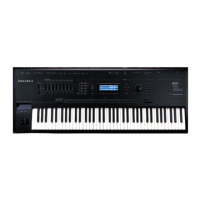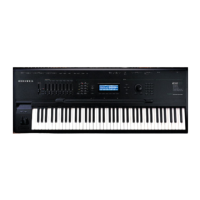Sampling with the K2000
Setting Up For Sampling
2-1
Chapter 2
Sampling with the K2000
Setting Up For Sampling
Before you begin sampling, you’ll need to connect the proper cables from your sample source to
your K2000. The cables and input jacks you use depend on the sample format you choose, and
the output configuration of your sample source. Note that sampling requires K2000 system
software Version 2 or higher.
Cables and Input Jacks
If you’re going to be sampling from an analog source, connect a standard 1/4-inch mono or
stereo cable (a typical guitar cable) from the output of your sample source to the 1/4-inch analog
input jack on the K2000. If you have a K2000R or K2000RS, use the 1/4-inch jacks if you’re
sending an unbalanced signal, or the XLR jacks on the front panel if you’re sending a balanced
signal. Avoid sending a balanced signal when you’re making stereo samples, since doing so can
cause phase cancellations in your samples.
Using a mono cable will send the signal to the K2000’s left channel. If you use a mono cable, be
sure to set the Mode parameter on the Sample mode page to a value of Mono(L).
If you’re using a digital sample source, you can use either a coaxial cable or an optical cable,
depending on the output format of your sample source. The coaxial input on the K2000 accepts
a standard male XLR fitting. Depending on your sample source (a commercial DAT deck, for
example), you may need to use a cable (or a cable and adaptor) with an RCA connector on one
end and an XLR connector on the other. The K2000’s XLR input is configured as follows: Pin 1 is
Common, Pin 2 is High, and Pin 3 is Low.
If your digital sample source has an optical output, connect your cable to the optical input jack
above the coaxial jack on the K2000’s rear panel. This jack is covered by a small plug which is
easily removed. This plug should be kept in place whenever the optical input is not in use, since
dust or dirt can cause the optical input to malfunction.
When you’re ready to record samples, you’ll go to the Sample mode page. There are two ways to
to get to it: by pressing the Sample soft button in Master mode, or by pressing the MIDI mode
button while in the Keymap Editor. The appearance of this page will differ slightly depending
on whether you’re sampling an analog or digital signal.
Sampling Analog Signals
The K2000’s analog sampling input is optimized for a low-impedance line level signal (-10
dBm). With a line level signal, an input gain setting of 0 dB should prevent any clipping of the
sample even at maximum output from the source. You can compensate for lower input levels
with the Gain parameter on the Sample mode page.
If you’re sampling through a microphone, you’ll probably want to use a preamp to optimize
your signal-to-noise ratio. If you don’t have a preamp, you can adjust the Gain parameter. A
setting of 21 dB will give you reasonable results for many applications. This will increase the
noise level as well, however.

